Nursing Assignment: Evidence-Based Practice on Hand Hygiene in Nursing
VerifiedAdded on 2021/05/31
|18
|4357
|27
Report
AI Summary
This nursing assignment report explores the effectiveness of hand hygiene procedures in reducing nosocomial infections among healthcare workers. The study employed a PICO framework to formulate the research question and establish inclusion and exclusion criteria. A literature search was conducted in April 2018, utilizing the Hybrid Discovery (HyDi) search engine and PubMed database. The search included articles published in English from 2013-2018, focusing on randomized controlled trials (RCTs), systematic reviews, and observational studies. Keywords such as "hand hygiene," "infection control," and "nosocomial" were used in various combinations. The report details the search strategy, including filters and inclusion/exclusion criteria, and summarizes the findings, highlighting the relevance of hand hygiene practices in minimizing the spread of infections in hospital settings. The report also provides the number of hits obtained from each search, the relevance of the articles found and the types of studies included in the final analysis.
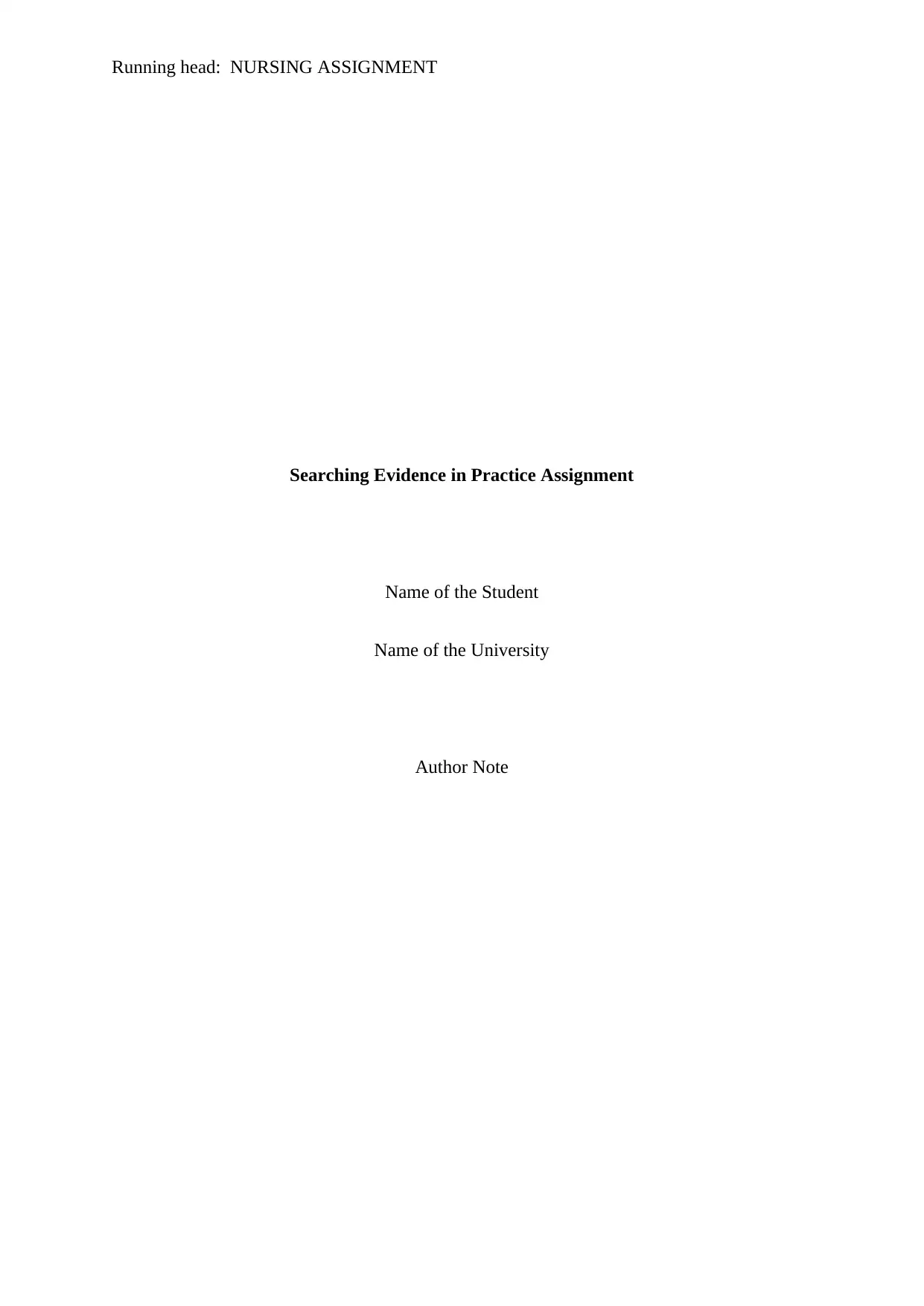
Running head: NURSING ASSIGNMENT
Searching Evidence in Practice Assignment
Name of the Student
Name of the University
Author Note
Searching Evidence in Practice Assignment
Name of the Student
Name of the University
Author Note
Paraphrase This Document
Need a fresh take? Get an instant paraphrase of this document with our AI Paraphraser
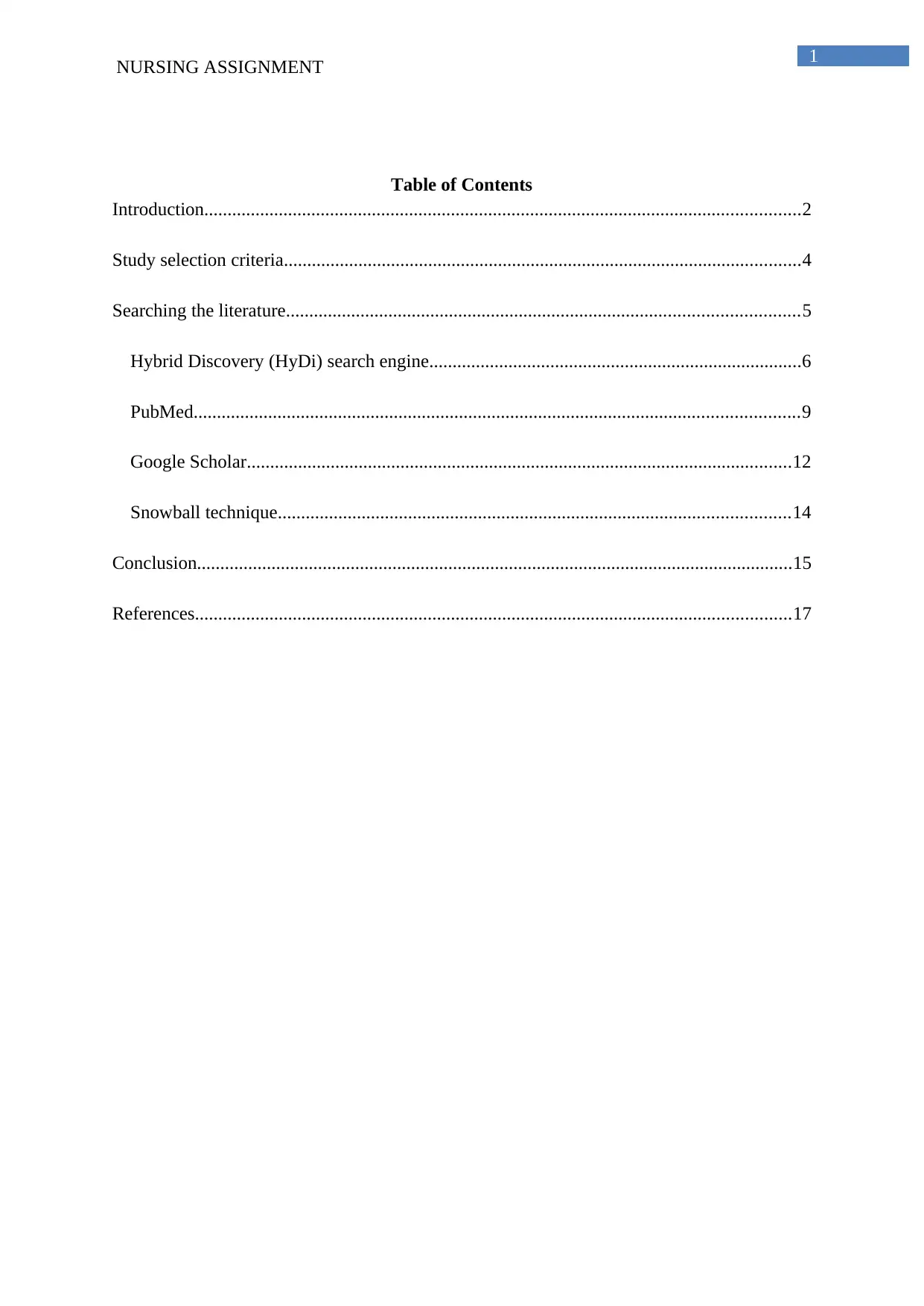
1
NURSING ASSIGNMENT
Table of Contents
Introduction................................................................................................................................2
Study selection criteria...............................................................................................................4
Searching the literature..............................................................................................................5
Hybrid Discovery (HyDi) search engine................................................................................6
PubMed..................................................................................................................................9
Google Scholar.....................................................................................................................12
Snowball technique..............................................................................................................14
Conclusion................................................................................................................................15
References................................................................................................................................17
NURSING ASSIGNMENT
Table of Contents
Introduction................................................................................................................................2
Study selection criteria...............................................................................................................4
Searching the literature..............................................................................................................5
Hybrid Discovery (HyDi) search engine................................................................................6
PubMed..................................................................................................................................9
Google Scholar.....................................................................................................................12
Snowball technique..............................................................................................................14
Conclusion................................................................................................................................15
References................................................................................................................................17
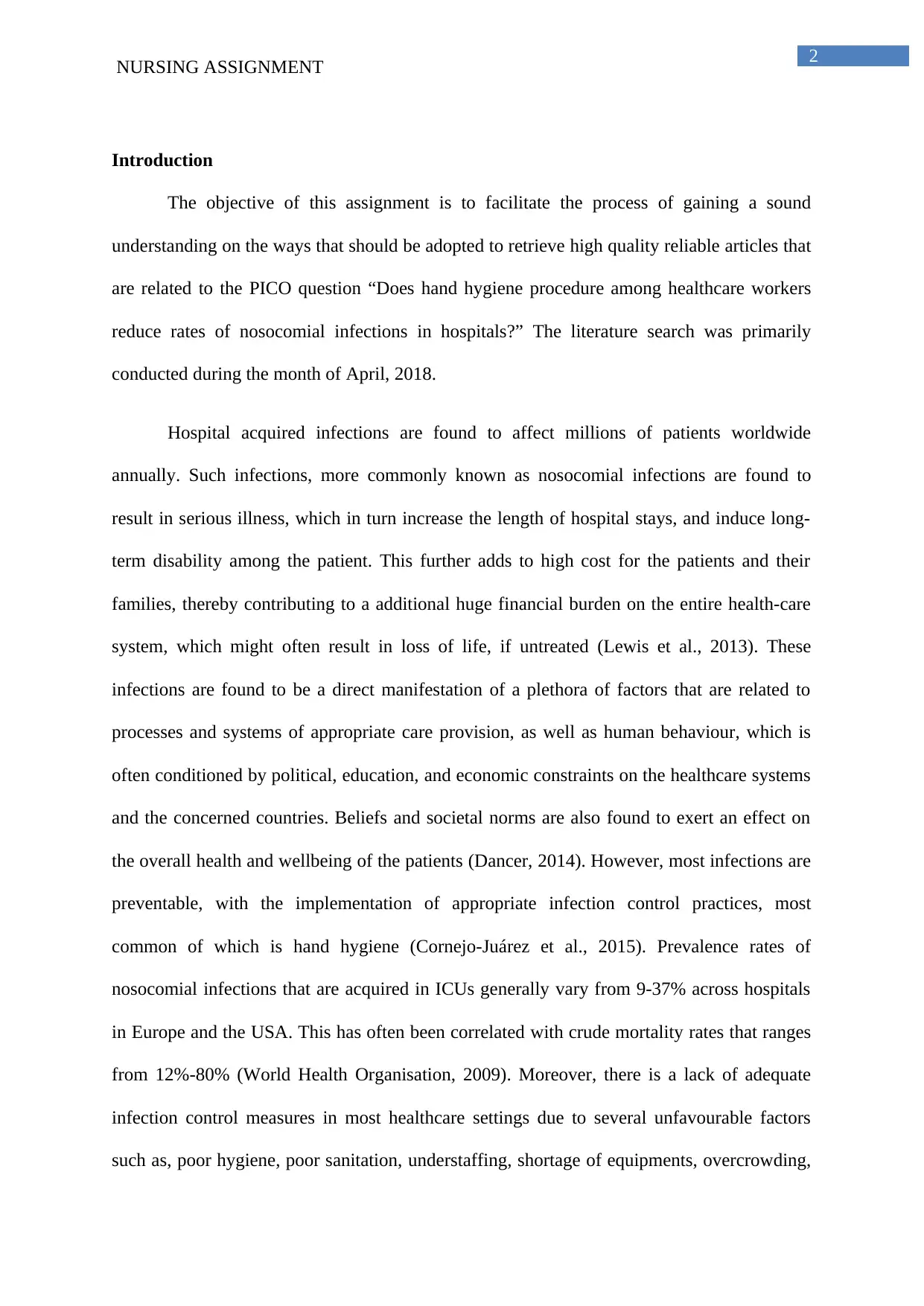
2
NURSING ASSIGNMENT
Introduction
The objective of this assignment is to facilitate the process of gaining a sound
understanding on the ways that should be adopted to retrieve high quality reliable articles that
are related to the PICO question “Does hand hygiene procedure among healthcare workers
reduce rates of nosocomial infections in hospitals?” The literature search was primarily
conducted during the month of April, 2018.
Hospital acquired infections are found to affect millions of patients worldwide
annually. Such infections, more commonly known as nosocomial infections are found to
result in serious illness, which in turn increase the length of hospital stays, and induce long-
term disability among the patient. This further adds to high cost for the patients and their
families, thereby contributing to a additional huge financial burden on the entire health-care
system, which might often result in loss of life, if untreated (Lewis et al., 2013). These
infections are found to be a direct manifestation of a plethora of factors that are related to
processes and systems of appropriate care provision, as well as human behaviour, which is
often conditioned by political, education, and economic constraints on the healthcare systems
and the concerned countries. Beliefs and societal norms are also found to exert an effect on
the overall health and wellbeing of the patients (Dancer, 2014). However, most infections are
preventable, with the implementation of appropriate infection control practices, most
common of which is hand hygiene (Cornejo-Juárez et al., 2015). Prevalence rates of
nosocomial infections that are acquired in ICUs generally vary from 9-37% across hospitals
in Europe and the USA. This has often been correlated with crude mortality rates that ranges
from 12%-80% (World Health Organisation, 2009). Moreover, there is a lack of adequate
infection control measures in most healthcare settings due to several unfavourable factors
such as, poor hygiene, poor sanitation, understaffing, shortage of equipments, overcrowding,
NURSING ASSIGNMENT
Introduction
The objective of this assignment is to facilitate the process of gaining a sound
understanding on the ways that should be adopted to retrieve high quality reliable articles that
are related to the PICO question “Does hand hygiene procedure among healthcare workers
reduce rates of nosocomial infections in hospitals?” The literature search was primarily
conducted during the month of April, 2018.
Hospital acquired infections are found to affect millions of patients worldwide
annually. Such infections, more commonly known as nosocomial infections are found to
result in serious illness, which in turn increase the length of hospital stays, and induce long-
term disability among the patient. This further adds to high cost for the patients and their
families, thereby contributing to a additional huge financial burden on the entire health-care
system, which might often result in loss of life, if untreated (Lewis et al., 2013). These
infections are found to be a direct manifestation of a plethora of factors that are related to
processes and systems of appropriate care provision, as well as human behaviour, which is
often conditioned by political, education, and economic constraints on the healthcare systems
and the concerned countries. Beliefs and societal norms are also found to exert an effect on
the overall health and wellbeing of the patients (Dancer, 2014). However, most infections are
preventable, with the implementation of appropriate infection control practices, most
common of which is hand hygiene (Cornejo-Juárez et al., 2015). Prevalence rates of
nosocomial infections that are acquired in ICUs generally vary from 9-37% across hospitals
in Europe and the USA. This has often been correlated with crude mortality rates that ranges
from 12%-80% (World Health Organisation, 2009). Moreover, there is a lack of adequate
infection control measures in most healthcare settings due to several unfavourable factors
such as, poor hygiene, poor sanitation, understaffing, shortage of equipments, overcrowding,
⊘ This is a preview!⊘
Do you want full access?
Subscribe today to unlock all pages.

Trusted by 1+ million students worldwide
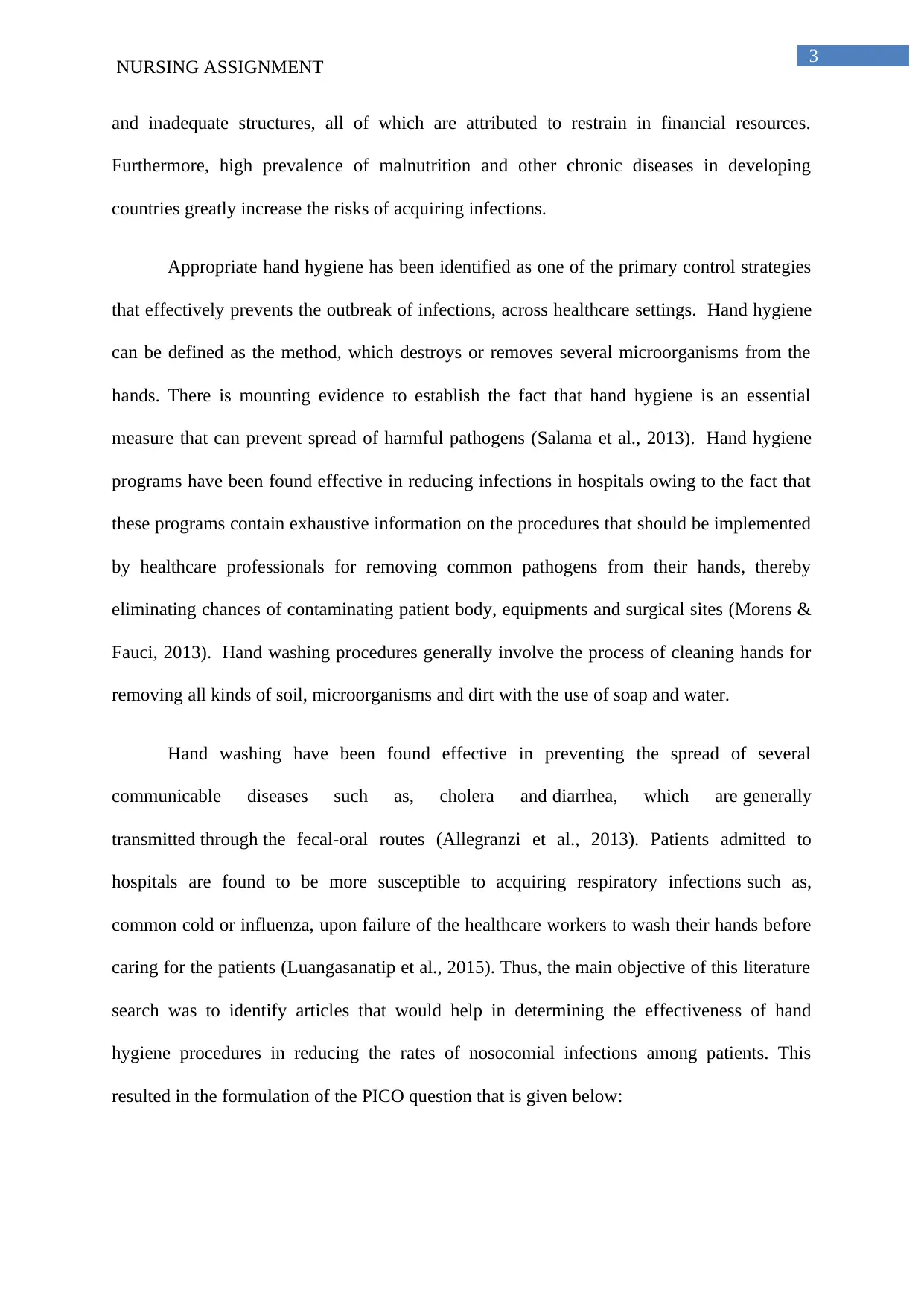
3
NURSING ASSIGNMENT
and inadequate structures, all of which are attributed to restrain in financial resources.
Furthermore, high prevalence of malnutrition and other chronic diseases in developing
countries greatly increase the risks of acquiring infections.
Appropriate hand hygiene has been identified as one of the primary control strategies
that effectively prevents the outbreak of infections, across healthcare settings. Hand hygiene
can be defined as the method, which destroys or removes several microorganisms from the
hands. There is mounting evidence to establish the fact that hand hygiene is an essential
measure that can prevent spread of harmful pathogens (Salama et al., 2013). Hand hygiene
programs have been found effective in reducing infections in hospitals owing to the fact that
these programs contain exhaustive information on the procedures that should be implemented
by healthcare professionals for removing common pathogens from their hands, thereby
eliminating chances of contaminating patient body, equipments and surgical sites (Morens &
Fauci, 2013). Hand washing procedures generally involve the process of cleaning hands for
removing all kinds of soil, microorganisms and dirt with the use of soap and water.
Hand washing have been found effective in preventing the spread of several
communicable diseases such as, cholera and diarrhea, which are generally
transmitted through the fecal-oral routes (Allegranzi et al., 2013). Patients admitted to
hospitals are found to be more susceptible to acquiring respiratory infections such as,
common cold or influenza, upon failure of the healthcare workers to wash their hands before
caring for the patients (Luangasanatip et al., 2015). Thus, the main objective of this literature
search was to identify articles that would help in determining the effectiveness of hand
hygiene procedures in reducing the rates of nosocomial infections among patients. This
resulted in the formulation of the PICO question that is given below:
NURSING ASSIGNMENT
and inadequate structures, all of which are attributed to restrain in financial resources.
Furthermore, high prevalence of malnutrition and other chronic diseases in developing
countries greatly increase the risks of acquiring infections.
Appropriate hand hygiene has been identified as one of the primary control strategies
that effectively prevents the outbreak of infections, across healthcare settings. Hand hygiene
can be defined as the method, which destroys or removes several microorganisms from the
hands. There is mounting evidence to establish the fact that hand hygiene is an essential
measure that can prevent spread of harmful pathogens (Salama et al., 2013). Hand hygiene
programs have been found effective in reducing infections in hospitals owing to the fact that
these programs contain exhaustive information on the procedures that should be implemented
by healthcare professionals for removing common pathogens from their hands, thereby
eliminating chances of contaminating patient body, equipments and surgical sites (Morens &
Fauci, 2013). Hand washing procedures generally involve the process of cleaning hands for
removing all kinds of soil, microorganisms and dirt with the use of soap and water.
Hand washing have been found effective in preventing the spread of several
communicable diseases such as, cholera and diarrhea, which are generally
transmitted through the fecal-oral routes (Allegranzi et al., 2013). Patients admitted to
hospitals are found to be more susceptible to acquiring respiratory infections such as,
common cold or influenza, upon failure of the healthcare workers to wash their hands before
caring for the patients (Luangasanatip et al., 2015). Thus, the main objective of this literature
search was to identify articles that would help in determining the effectiveness of hand
hygiene procedures in reducing the rates of nosocomial infections among patients. This
resulted in the formulation of the PICO question that is given below:
Paraphrase This Document
Need a fresh take? Get an instant paraphrase of this document with our AI Paraphraser
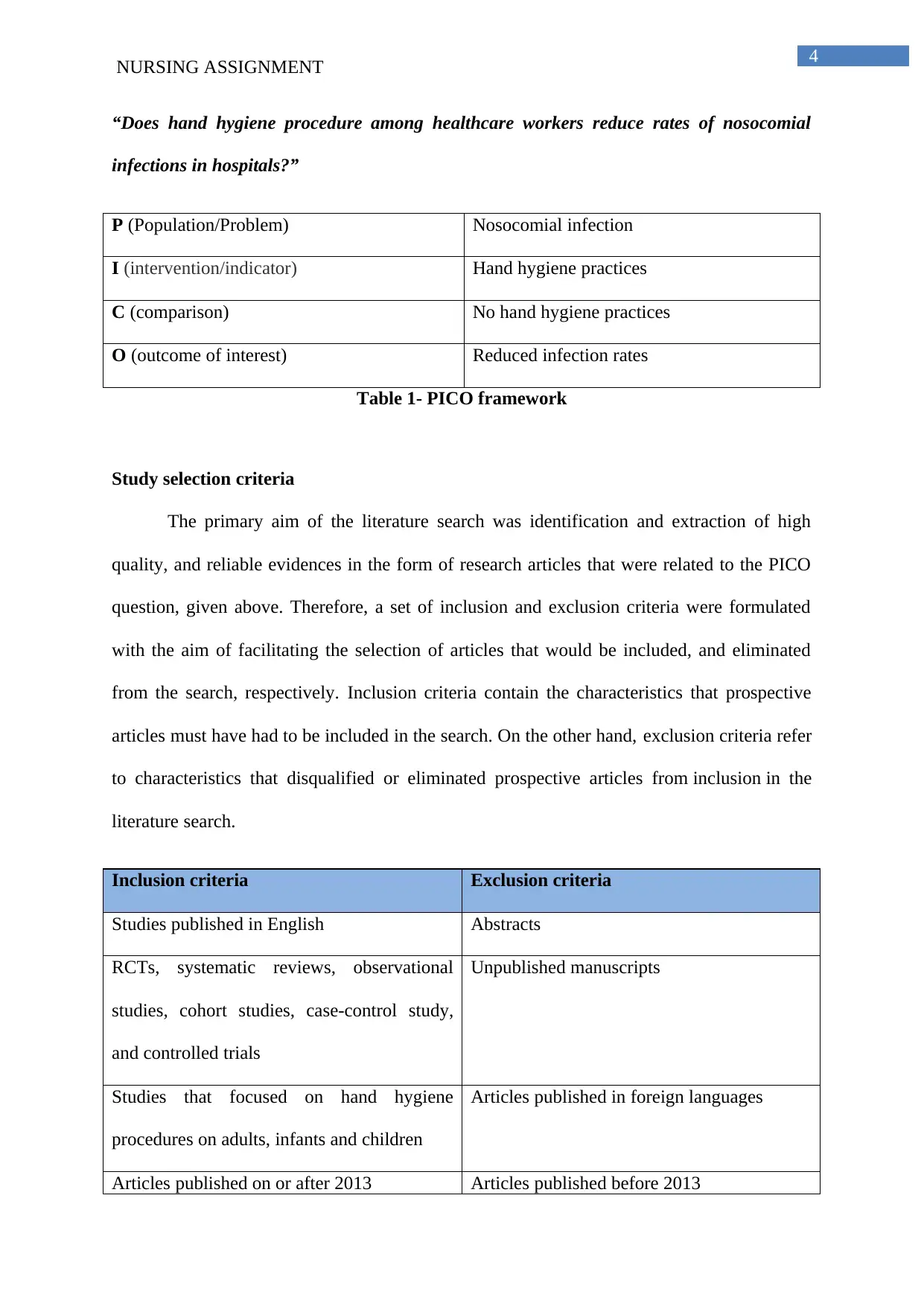
4
NURSING ASSIGNMENT
“Does hand hygiene procedure among healthcare workers reduce rates of nosocomial
infections in hospitals?”
P (Population/Problem) Nosocomial infection
I (intervention/indicator) Hand hygiene practices
C (comparison) No hand hygiene practices
O (outcome of interest) Reduced infection rates
Table 1- PICO framework
Study selection criteria
The primary aim of the literature search was identification and extraction of high
quality, and reliable evidences in the form of research articles that were related to the PICO
question, given above. Therefore, a set of inclusion and exclusion criteria were formulated
with the aim of facilitating the selection of articles that would be included, and eliminated
from the search, respectively. Inclusion criteria contain the characteristics that prospective
articles must have had to be included in the search. On the other hand, exclusion criteria refer
to characteristics that disqualified or eliminated prospective articles from inclusion in the
literature search.
Inclusion criteria Exclusion criteria
Studies published in English Abstracts
RCTs, systematic reviews, observational
studies, cohort studies, case-control study,
and controlled trials
Unpublished manuscripts
Studies that focused on hand hygiene
procedures on adults, infants and children
Articles published in foreign languages
Articles published on or after 2013 Articles published before 2013
NURSING ASSIGNMENT
“Does hand hygiene procedure among healthcare workers reduce rates of nosocomial
infections in hospitals?”
P (Population/Problem) Nosocomial infection
I (intervention/indicator) Hand hygiene practices
C (comparison) No hand hygiene practices
O (outcome of interest) Reduced infection rates
Table 1- PICO framework
Study selection criteria
The primary aim of the literature search was identification and extraction of high
quality, and reliable evidences in the form of research articles that were related to the PICO
question, given above. Therefore, a set of inclusion and exclusion criteria were formulated
with the aim of facilitating the selection of articles that would be included, and eliminated
from the search, respectively. Inclusion criteria contain the characteristics that prospective
articles must have had to be included in the search. On the other hand, exclusion criteria refer
to characteristics that disqualified or eliminated prospective articles from inclusion in the
literature search.
Inclusion criteria Exclusion criteria
Studies published in English Abstracts
RCTs, systematic reviews, observational
studies, cohort studies, case-control study,
and controlled trials
Unpublished manuscripts
Studies that focused on hand hygiene
procedures on adults, infants and children
Articles published in foreign languages
Articles published on or after 2013 Articles published before 2013
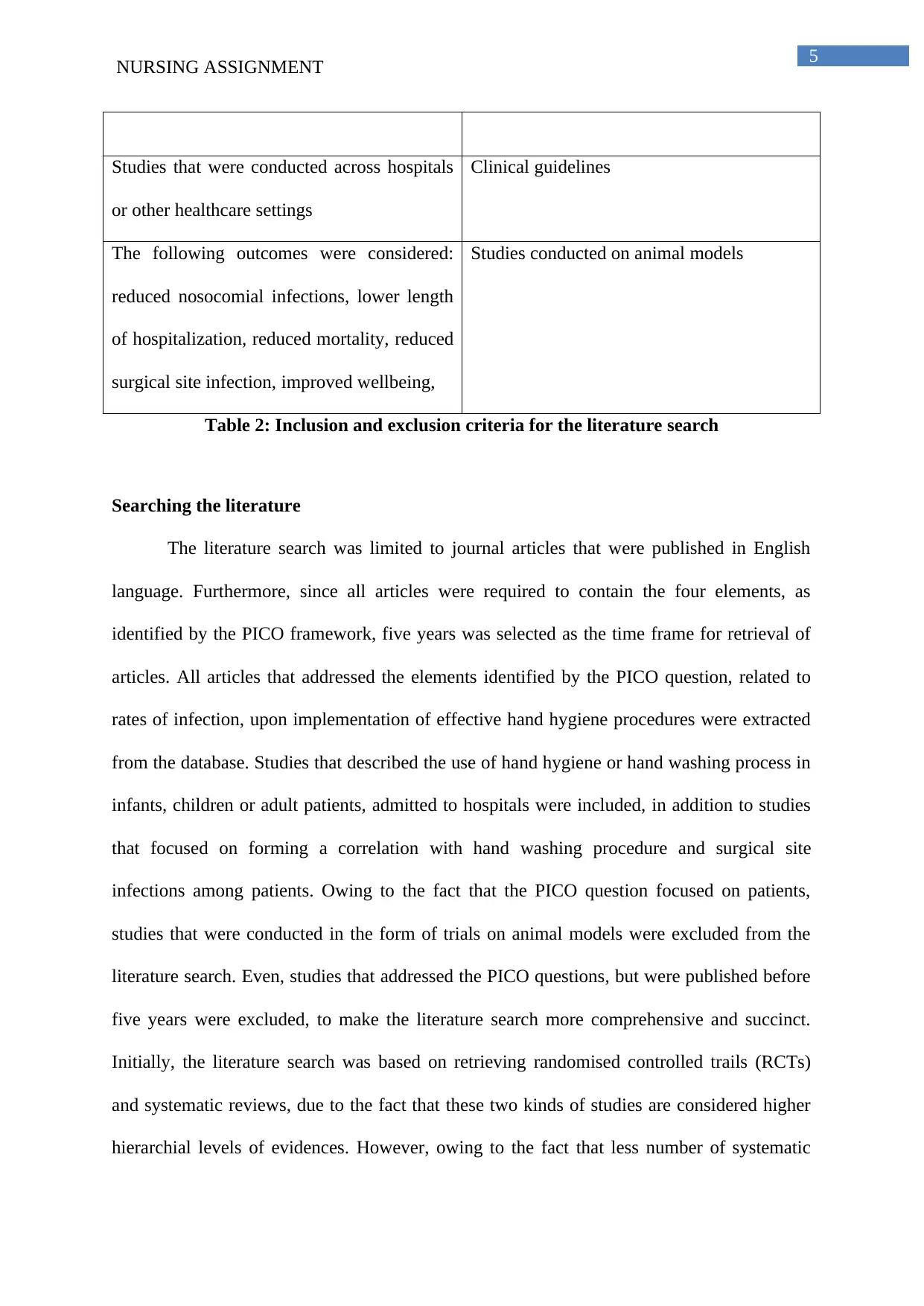
5
NURSING ASSIGNMENT
Studies that were conducted across hospitals
or other healthcare settings
Clinical guidelines
The following outcomes were considered:
reduced nosocomial infections, lower length
of hospitalization, reduced mortality, reduced
surgical site infection, improved wellbeing,
Studies conducted on animal models
Table 2: Inclusion and exclusion criteria for the literature search
Searching the literature
The literature search was limited to journal articles that were published in English
language. Furthermore, since all articles were required to contain the four elements, as
identified by the PICO framework, five years was selected as the time frame for retrieval of
articles. All articles that addressed the elements identified by the PICO question, related to
rates of infection, upon implementation of effective hand hygiene procedures were extracted
from the database. Studies that described the use of hand hygiene or hand washing process in
infants, children or adult patients, admitted to hospitals were included, in addition to studies
that focused on forming a correlation with hand washing procedure and surgical site
infections among patients. Owing to the fact that the PICO question focused on patients,
studies that were conducted in the form of trials on animal models were excluded from the
literature search. Even, studies that addressed the PICO questions, but were published before
five years were excluded, to make the literature search more comprehensive and succinct.
Initially, the literature search was based on retrieving randomised controlled trails (RCTs)
and systematic reviews, due to the fact that these two kinds of studies are considered higher
hierarchial levels of evidences. However, owing to the fact that less number of systematic
NURSING ASSIGNMENT
Studies that were conducted across hospitals
or other healthcare settings
Clinical guidelines
The following outcomes were considered:
reduced nosocomial infections, lower length
of hospitalization, reduced mortality, reduced
surgical site infection, improved wellbeing,
Studies conducted on animal models
Table 2: Inclusion and exclusion criteria for the literature search
Searching the literature
The literature search was limited to journal articles that were published in English
language. Furthermore, since all articles were required to contain the four elements, as
identified by the PICO framework, five years was selected as the time frame for retrieval of
articles. All articles that addressed the elements identified by the PICO question, related to
rates of infection, upon implementation of effective hand hygiene procedures were extracted
from the database. Studies that described the use of hand hygiene or hand washing process in
infants, children or adult patients, admitted to hospitals were included, in addition to studies
that focused on forming a correlation with hand washing procedure and surgical site
infections among patients. Owing to the fact that the PICO question focused on patients,
studies that were conducted in the form of trials on animal models were excluded from the
literature search. Even, studies that addressed the PICO questions, but were published before
five years were excluded, to make the literature search more comprehensive and succinct.
Initially, the literature search was based on retrieving randomised controlled trails (RCTs)
and systematic reviews, due to the fact that these two kinds of studies are considered higher
hierarchial levels of evidences. However, owing to the fact that less number of systematic
⊘ This is a preview!⊘
Do you want full access?
Subscribe today to unlock all pages.

Trusted by 1+ million students worldwide
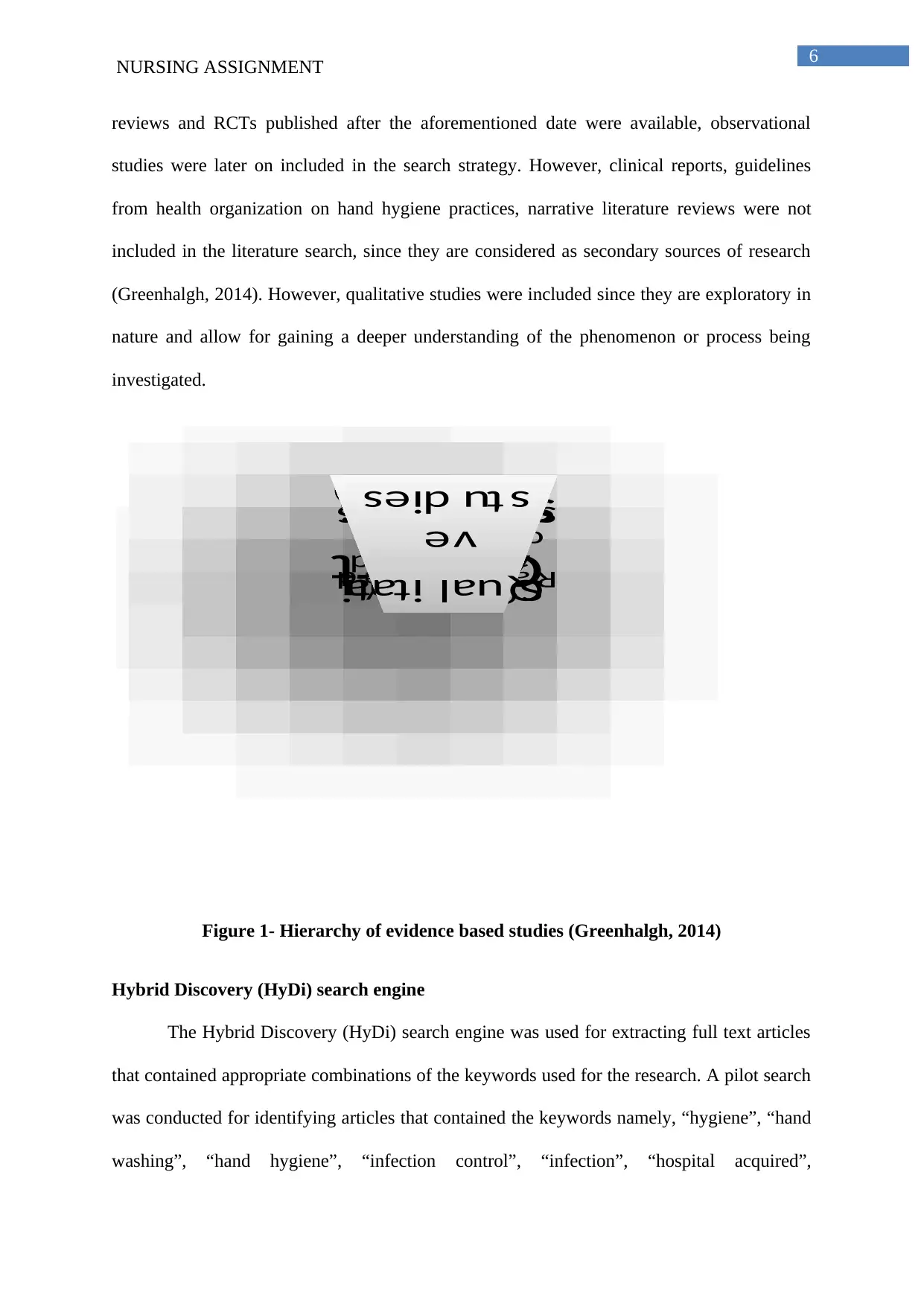
6
NURSING ASSIGNMENT
reviews and RCTs published after the aforementioned date were available, observational
studies were later on included in the search strategy. However, clinical reports, guidelines
from health organization on hand hygiene practices, narrative literature reviews were not
included in the literature search, since they are considered as secondary sources of research
(Greenhalgh, 2014). However, qualitative studies were included since they are exploratory in
nature and allow for gaining a deeper understanding of the phenomenon or process being
investigated.
Figure 1- Hierarchy of evidence based studies (Greenhalgh, 2014)
Hybrid Discovery (HyDi) search engine
The Hybrid Discovery (HyDi) search engine was used for extracting full text articles
that contained appropriate combinations of the keywords used for the research. A pilot search
was conducted for identifying articles that contained the keywords namely, “hygiene”, “hand
washing”, “hand hygiene”, “infection control”, “infection”, “hospital acquired”,
Sys te ma
tic
re views
C ri tic al l y
ap p ra i se d
to pi c s
(g ui d el i n es )
A rti cle
s ynop s es
R an d o mi se d
co n tro l le d
tri al s
Cohort
studies
Case-
control
st udies
Qual itati
ve
s tu dies
NURSING ASSIGNMENT
reviews and RCTs published after the aforementioned date were available, observational
studies were later on included in the search strategy. However, clinical reports, guidelines
from health organization on hand hygiene practices, narrative literature reviews were not
included in the literature search, since they are considered as secondary sources of research
(Greenhalgh, 2014). However, qualitative studies were included since they are exploratory in
nature and allow for gaining a deeper understanding of the phenomenon or process being
investigated.
Figure 1- Hierarchy of evidence based studies (Greenhalgh, 2014)
Hybrid Discovery (HyDi) search engine
The Hybrid Discovery (HyDi) search engine was used for extracting full text articles
that contained appropriate combinations of the keywords used for the research. A pilot search
was conducted for identifying articles that contained the keywords namely, “hygiene”, “hand
washing”, “hand hygiene”, “infection control”, “infection”, “hospital acquired”,
Sys te ma
tic
re views
C ri tic al l y
ap p ra i se d
to pi c s
(g ui d el i n es )
A rti cle
s ynop s es
R an d o mi se d
co n tro l le d
tri al s
Cohort
studies
Case-
control
st udies
Qual itati
ve
s tu dies
Paraphrase This Document
Need a fresh take? Get an instant paraphrase of this document with our AI Paraphraser
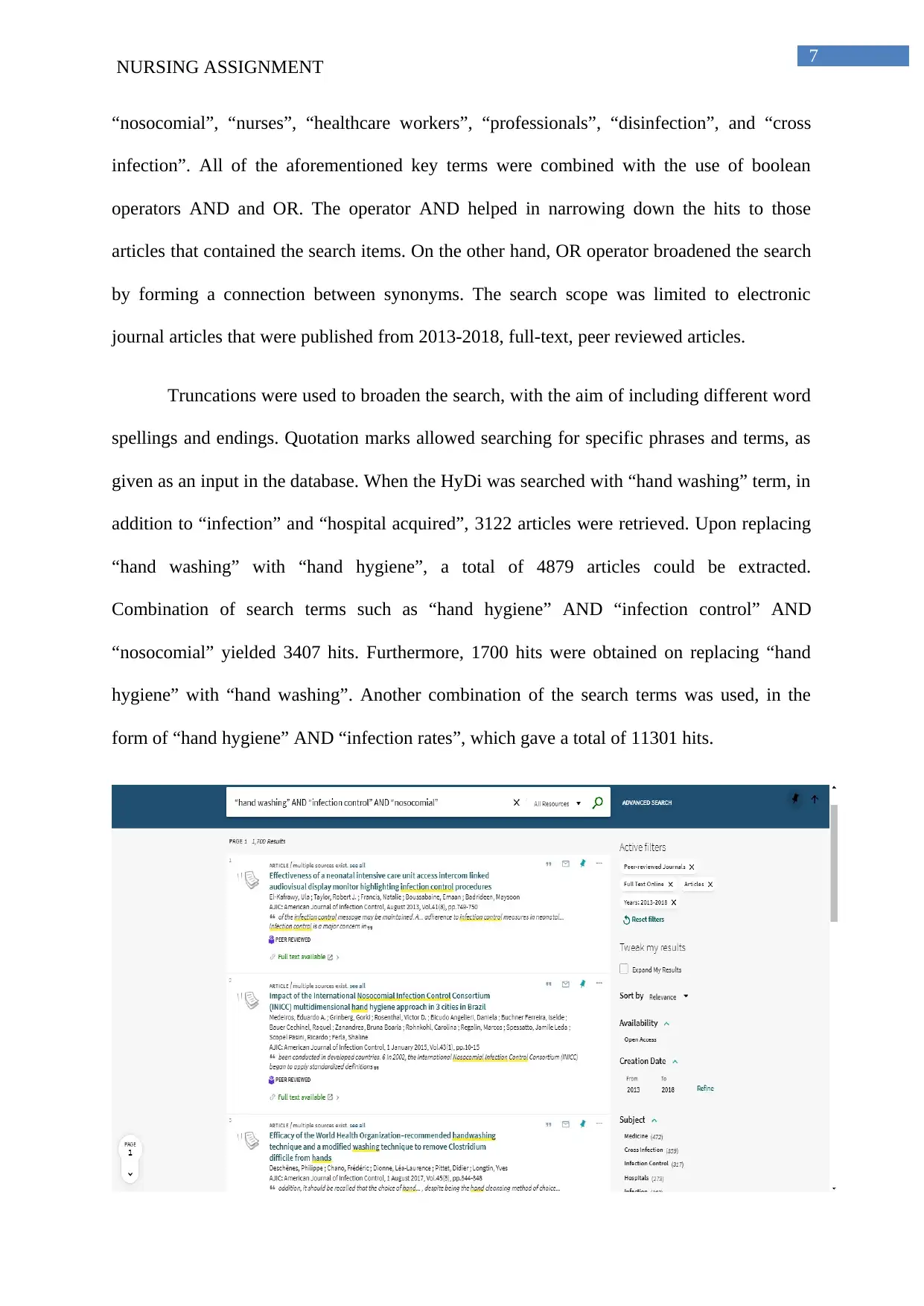
7
NURSING ASSIGNMENT
“nosocomial”, “nurses”, “healthcare workers”, “professionals”, “disinfection”, and “cross
infection”. All of the aforementioned key terms were combined with the use of boolean
operators AND and OR. The operator AND helped in narrowing down the hits to those
articles that contained the search items. On the other hand, OR operator broadened the search
by forming a connection between synonyms. The search scope was limited to electronic
journal articles that were published from 2013-2018, full-text, peer reviewed articles.
Truncations were used to broaden the search, with the aim of including different word
spellings and endings. Quotation marks allowed searching for specific phrases and terms, as
given as an input in the database. When the HyDi was searched with “hand washing” term, in
addition to “infection” and “hospital acquired”, 3122 articles were retrieved. Upon replacing
“hand washing” with “hand hygiene”, a total of 4879 articles could be extracted.
Combination of search terms such as “hand hygiene” AND “infection control” AND
“nosocomial” yielded 3407 hits. Furthermore, 1700 hits were obtained on replacing “hand
hygiene” with “hand washing”. Another combination of the search terms was used, in the
form of “hand hygiene” AND “infection rates”, which gave a total of 11301 hits.
NURSING ASSIGNMENT
“nosocomial”, “nurses”, “healthcare workers”, “professionals”, “disinfection”, and “cross
infection”. All of the aforementioned key terms were combined with the use of boolean
operators AND and OR. The operator AND helped in narrowing down the hits to those
articles that contained the search items. On the other hand, OR operator broadened the search
by forming a connection between synonyms. The search scope was limited to electronic
journal articles that were published from 2013-2018, full-text, peer reviewed articles.
Truncations were used to broaden the search, with the aim of including different word
spellings and endings. Quotation marks allowed searching for specific phrases and terms, as
given as an input in the database. When the HyDi was searched with “hand washing” term, in
addition to “infection” and “hospital acquired”, 3122 articles were retrieved. Upon replacing
“hand washing” with “hand hygiene”, a total of 4879 articles could be extracted.
Combination of search terms such as “hand hygiene” AND “infection control” AND
“nosocomial” yielded 3407 hits. Furthermore, 1700 hits were obtained on replacing “hand
hygiene” with “hand washing”. Another combination of the search terms was used, in the
form of “hand hygiene” AND “infection rates”, which gave a total of 11301 hits.
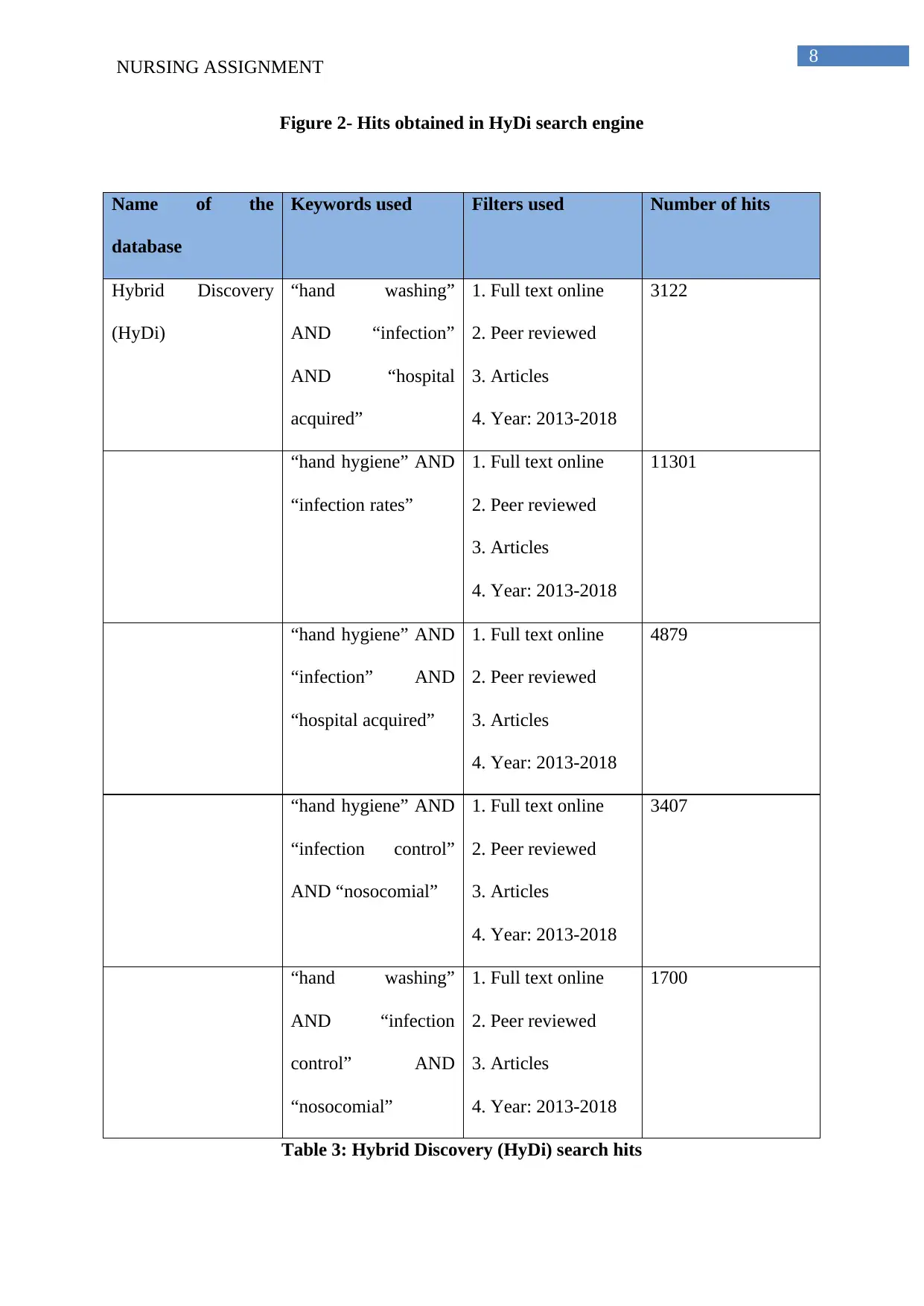
8
NURSING ASSIGNMENT
Figure 2- Hits obtained in HyDi search engine
Name of the
database
Keywords used Filters used Number of hits
Hybrid Discovery
(HyDi)
“hand washing”
AND “infection”
AND “hospital
acquired”
1. Full text online
2. Peer reviewed
3. Articles
4. Year: 2013-2018
3122
“hand hygiene” AND
“infection rates”
1. Full text online
2. Peer reviewed
3. Articles
4. Year: 2013-2018
11301
“hand hygiene” AND
“infection” AND
“hospital acquired”
1. Full text online
2. Peer reviewed
3. Articles
4. Year: 2013-2018
4879
“hand hygiene” AND
“infection control”
AND “nosocomial”
1. Full text online
2. Peer reviewed
3. Articles
4. Year: 2013-2018
3407
“hand washing”
AND “infection
control” AND
“nosocomial”
1. Full text online
2. Peer reviewed
3. Articles
4. Year: 2013-2018
1700
Table 3: Hybrid Discovery (HyDi) search hits
NURSING ASSIGNMENT
Figure 2- Hits obtained in HyDi search engine
Name of the
database
Keywords used Filters used Number of hits
Hybrid Discovery
(HyDi)
“hand washing”
AND “infection”
AND “hospital
acquired”
1. Full text online
2. Peer reviewed
3. Articles
4. Year: 2013-2018
3122
“hand hygiene” AND
“infection rates”
1. Full text online
2. Peer reviewed
3. Articles
4. Year: 2013-2018
11301
“hand hygiene” AND
“infection” AND
“hospital acquired”
1. Full text online
2. Peer reviewed
3. Articles
4. Year: 2013-2018
4879
“hand hygiene” AND
“infection control”
AND “nosocomial”
1. Full text online
2. Peer reviewed
3. Articles
4. Year: 2013-2018
3407
“hand washing”
AND “infection
control” AND
“nosocomial”
1. Full text online
2. Peer reviewed
3. Articles
4. Year: 2013-2018
1700
Table 3: Hybrid Discovery (HyDi) search hits
⊘ This is a preview!⊘
Do you want full access?
Subscribe today to unlock all pages.

Trusted by 1+ million students worldwide
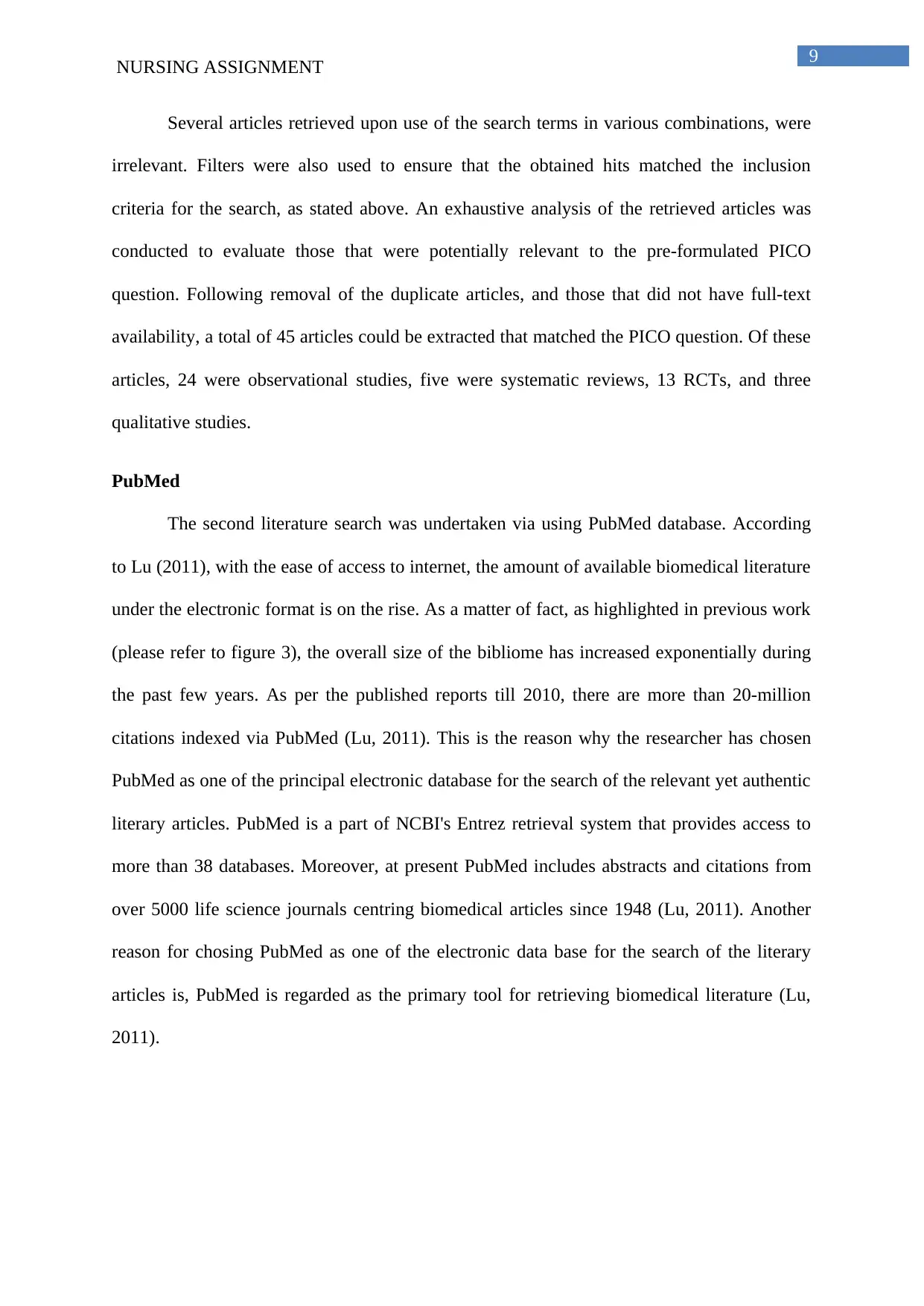
9
NURSING ASSIGNMENT
Several articles retrieved upon use of the search terms in various combinations, were
irrelevant. Filters were also used to ensure that the obtained hits matched the inclusion
criteria for the search, as stated above. An exhaustive analysis of the retrieved articles was
conducted to evaluate those that were potentially relevant to the pre-formulated PICO
question. Following removal of the duplicate articles, and those that did not have full-text
availability, a total of 45 articles could be extracted that matched the PICO question. Of these
articles, 24 were observational studies, five were systematic reviews, 13 RCTs, and three
qualitative studies.
PubMed
The second literature search was undertaken via using PubMed database. According
to Lu (2011), with the ease of access to internet, the amount of available biomedical literature
under the electronic format is on the rise. As a matter of fact, as highlighted in previous work
(please refer to figure 3), the overall size of the bibliome has increased exponentially during
the past few years. As per the published reports till 2010, there are more than 20-million
citations indexed via PubMed (Lu, 2011). This is the reason why the researcher has chosen
PubMed as one of the principal electronic database for the search of the relevant yet authentic
literary articles. PubMed is a part of NCBI's Entrez retrieval system that provides access to
more than 38 databases. Moreover, at present PubMed includes abstracts and citations from
over 5000 life science journals centring biomedical articles since 1948 (Lu, 2011). Another
reason for chosing PubMed as one of the electronic data base for the search of the literary
articles is, PubMed is regarded as the primary tool for retrieving biomedical literature (Lu,
2011).
NURSING ASSIGNMENT
Several articles retrieved upon use of the search terms in various combinations, were
irrelevant. Filters were also used to ensure that the obtained hits matched the inclusion
criteria for the search, as stated above. An exhaustive analysis of the retrieved articles was
conducted to evaluate those that were potentially relevant to the pre-formulated PICO
question. Following removal of the duplicate articles, and those that did not have full-text
availability, a total of 45 articles could be extracted that matched the PICO question. Of these
articles, 24 were observational studies, five were systematic reviews, 13 RCTs, and three
qualitative studies.
PubMed
The second literature search was undertaken via using PubMed database. According
to Lu (2011), with the ease of access to internet, the amount of available biomedical literature
under the electronic format is on the rise. As a matter of fact, as highlighted in previous work
(please refer to figure 3), the overall size of the bibliome has increased exponentially during
the past few years. As per the published reports till 2010, there are more than 20-million
citations indexed via PubMed (Lu, 2011). This is the reason why the researcher has chosen
PubMed as one of the principal electronic database for the search of the relevant yet authentic
literary articles. PubMed is a part of NCBI's Entrez retrieval system that provides access to
more than 38 databases. Moreover, at present PubMed includes abstracts and citations from
over 5000 life science journals centring biomedical articles since 1948 (Lu, 2011). Another
reason for chosing PubMed as one of the electronic data base for the search of the literary
articles is, PubMed is regarded as the primary tool for retrieving biomedical literature (Lu,
2011).
Paraphrase This Document
Need a fresh take? Get an instant paraphrase of this document with our AI Paraphraser
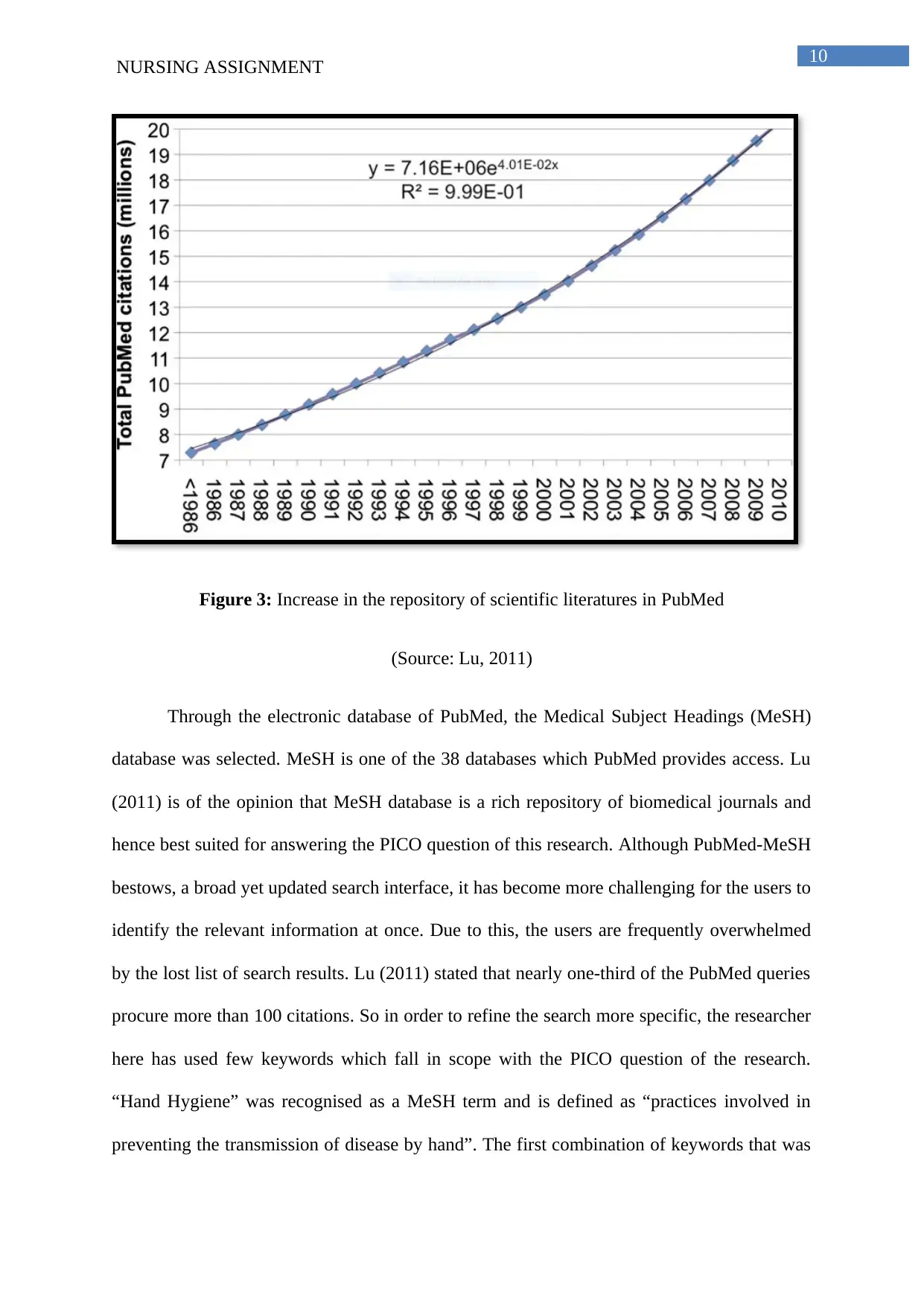
10
NURSING ASSIGNMENT
Figure 3: Increase in the repository of scientific literatures in PubMed
(Source: Lu, 2011)
Through the electronic database of PubMed, the Medical Subject Headings (MeSH)
database was selected. MeSH is one of the 38 databases which PubMed provides access. Lu
(2011) is of the opinion that MeSH database is a rich repository of biomedical journals and
hence best suited for answering the PICO question of this research. Although PubMed-MeSH
bestows, a broad yet updated search interface, it has become more challenging for the users to
identify the relevant information at once. Due to this, the users are frequently overwhelmed
by the lost list of search results. Lu (2011) stated that nearly one-third of the PubMed queries
procure more than 100 citations. So in order to refine the search more specific, the researcher
here has used few keywords which fall in scope with the PICO question of the research.
“Hand Hygiene” was recognised as a MeSH term and is defined as “practices involved in
preventing the transmission of disease by hand”. The first combination of keywords that was
NURSING ASSIGNMENT
Figure 3: Increase in the repository of scientific literatures in PubMed
(Source: Lu, 2011)
Through the electronic database of PubMed, the Medical Subject Headings (MeSH)
database was selected. MeSH is one of the 38 databases which PubMed provides access. Lu
(2011) is of the opinion that MeSH database is a rich repository of biomedical journals and
hence best suited for answering the PICO question of this research. Although PubMed-MeSH
bestows, a broad yet updated search interface, it has become more challenging for the users to
identify the relevant information at once. Due to this, the users are frequently overwhelmed
by the lost list of search results. Lu (2011) stated that nearly one-third of the PubMed queries
procure more than 100 citations. So in order to refine the search more specific, the researcher
here has used few keywords which fall in scope with the PICO question of the research.
“Hand Hygiene” was recognised as a MeSH term and is defined as “practices involved in
preventing the transmission of disease by hand”. The first combination of keywords that was
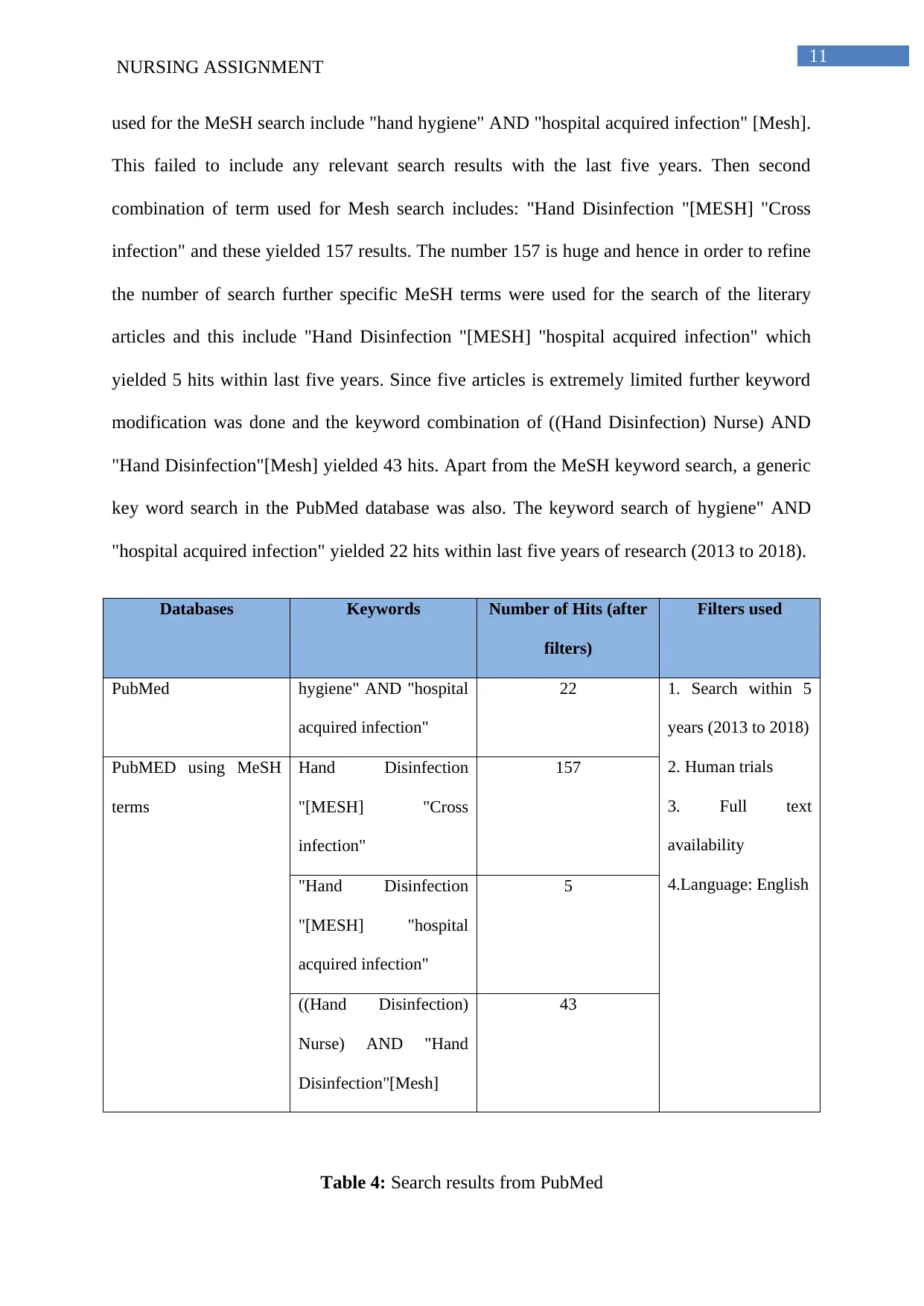
11
NURSING ASSIGNMENT
used for the MeSH search include "hand hygiene" AND "hospital acquired infection" [Mesh].
This failed to include any relevant search results with the last five years. Then second
combination of term used for Mesh search includes: "Hand Disinfection "[MESH] "Cross
infection" and these yielded 157 results. The number 157 is huge and hence in order to refine
the number of search further specific MeSH terms were used for the search of the literary
articles and this include "Hand Disinfection "[MESH] "hospital acquired infection" which
yielded 5 hits within last five years. Since five articles is extremely limited further keyword
modification was done and the keyword combination of ((Hand Disinfection) Nurse) AND
"Hand Disinfection"[Mesh] yielded 43 hits. Apart from the MeSH keyword search, a generic
key word search in the PubMed database was also. The keyword search of hygiene" AND
"hospital acquired infection" yielded 22 hits within last five years of research (2013 to 2018).
Databases Keywords Number of Hits (after
filters)
Filters used
PubMed hygiene" AND "hospital
acquired infection"
22 1. Search within 5
years (2013 to 2018)
2. Human trials
3. Full text
availability
4.Language: English
PubMED using MeSH
terms
Hand Disinfection
"[MESH] "Cross
infection"
157
"Hand Disinfection
"[MESH] "hospital
acquired infection"
5
((Hand Disinfection)
Nurse) AND "Hand
Disinfection"[Mesh]
43
Table 4: Search results from PubMed
NURSING ASSIGNMENT
used for the MeSH search include "hand hygiene" AND "hospital acquired infection" [Mesh].
This failed to include any relevant search results with the last five years. Then second
combination of term used for Mesh search includes: "Hand Disinfection "[MESH] "Cross
infection" and these yielded 157 results. The number 157 is huge and hence in order to refine
the number of search further specific MeSH terms were used for the search of the literary
articles and this include "Hand Disinfection "[MESH] "hospital acquired infection" which
yielded 5 hits within last five years. Since five articles is extremely limited further keyword
modification was done and the keyword combination of ((Hand Disinfection) Nurse) AND
"Hand Disinfection"[Mesh] yielded 43 hits. Apart from the MeSH keyword search, a generic
key word search in the PubMed database was also. The keyword search of hygiene" AND
"hospital acquired infection" yielded 22 hits within last five years of research (2013 to 2018).
Databases Keywords Number of Hits (after
filters)
Filters used
PubMed hygiene" AND "hospital
acquired infection"
22 1. Search within 5
years (2013 to 2018)
2. Human trials
3. Full text
availability
4.Language: English
PubMED using MeSH
terms
Hand Disinfection
"[MESH] "Cross
infection"
157
"Hand Disinfection
"[MESH] "hospital
acquired infection"
5
((Hand Disinfection)
Nurse) AND "Hand
Disinfection"[Mesh]
43
Table 4: Search results from PubMed
⊘ This is a preview!⊘
Do you want full access?
Subscribe today to unlock all pages.

Trusted by 1+ million students worldwide
1 out of 18
Related Documents
Your All-in-One AI-Powered Toolkit for Academic Success.
+13062052269
info@desklib.com
Available 24*7 on WhatsApp / Email
![[object Object]](/_next/static/media/star-bottom.7253800d.svg)
Unlock your academic potential
Copyright © 2020–2025 A2Z Services. All Rights Reserved. Developed and managed by ZUCOL.





